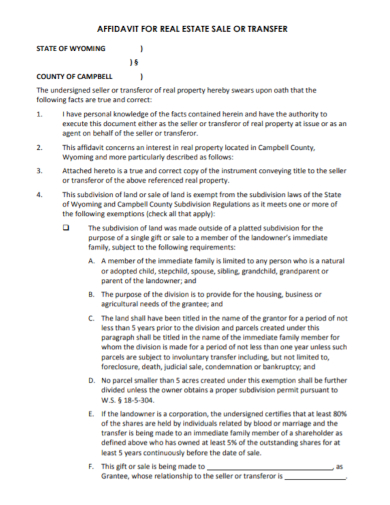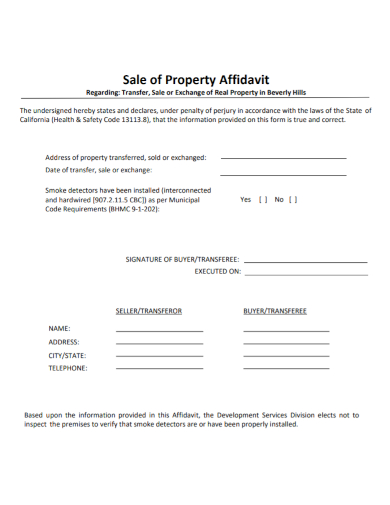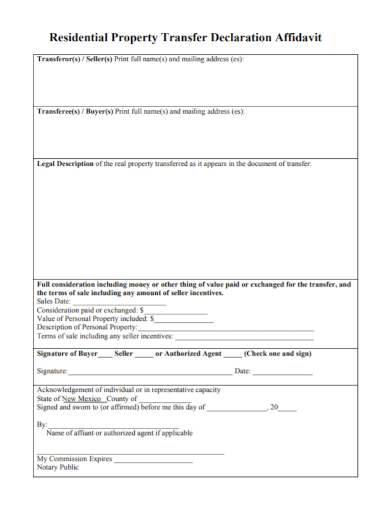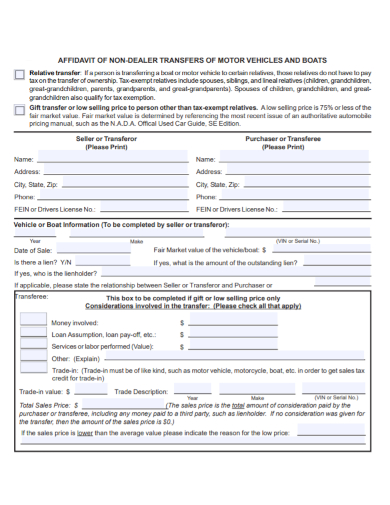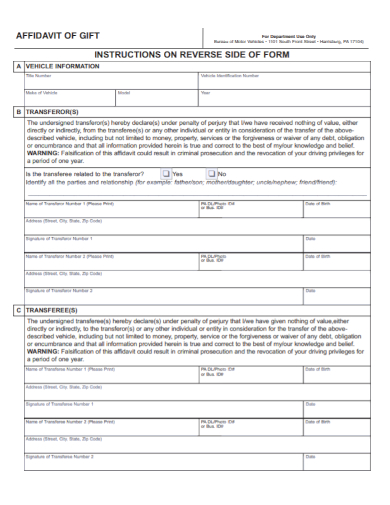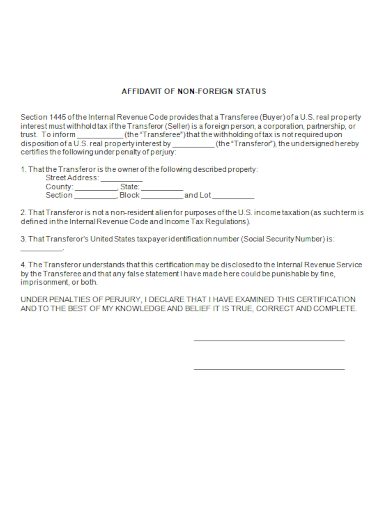When buying a real estate property, one of the most important things to consider is the ownership transfer from the seller to the buyer. This is one hectic task, as sometimes transferring property in the buyer’s name can really be difficult considering the many requirements and soaring fees associated with the purchase. One of the things that the buyer should also do to speed up the filing and transfer process is a legal statement that verifies their purchase of such property to ensure that the turning over of the property’s ownership is legal.
10+ Affidavit of Buyer/Transferee Samples
1. Residential Real Property Affidavit of Transferee
2. Affidavit for Real Estate Transferee
3. Property Affidavit of Transferee
4. Non-Foreign Affidavit of Buyer
5. Property Sale Affidavit of Buyer/Transferee
6. Water Well Affidavit of Transferee
7. Property Declaration Affidavit of Transferee
8. Affidavit of Non-Dealer Transferee
9. Residency Affidavit of Transferee
10. Affidavit of Gift Transferee
11. Affidavit of Non-Foreign Status Transferee
What Is the Affidavit of Buyer or Transferee?
The affidavit of buyer or transferee is a sworn statement verifying the legitimacy of the purchase of a property or asset including the identification of the buyer. This affidavit is written with the intention of the buyer to transfer ownership of the property or asset such as in the issuance of a land title or car registration. In addition, the document can also be used as a backup when paying for accrued interests in mortgages and bank loans that the previous owner has acquired during their ownership of such properties.
How to Make the Affidavit of Buyer or Transferee
When you begin making your affidavit, make sure that you have all the pertinent documents to back you up with your claims. Being well-versed in making legal documents is a plus, but you do not have to be a lawyer to do so. In this article, we will provide you with helpful tips that you can follow up on kickstarting your task today.
1. Start With Buyer Details
The first paragraph of your affidavit should be the details of the buyer. This includes the full name, address, marital status (especially if the buyers are purchasing an asset for conjugal ownership), and proof of identification (ID card details) which you will need to provide on the acknowledgment part. If there are two buyers, such as business partners, write the name of both parties with their details separated for easy identification.
2. Write The Details of the Purchase
In the succeeding paragraphs of the affidavit, you have to write down the details of the purchase that has been made. For properties, give a definite description of the facility or infrastructure, its area size, what the land is used for, the amount paid to the vendor, and the vendor’s name or details. For intangible assets such as stocks and bonds, you can describe the number of assets being transferred and who the assets belonged to previously. If the purchase has been issued with a Deed of Sale, then enter the date when the document was notarized.
3. Include a Space for Acknowledgment
The last part of your affidavit should have a space for notary acknowledgment. This is where the notary public would sign and seal to verify that you willingly and voluntarily made the affidavit without coercion. An affidavit is a jurat, so your acknowledgment part should go like this instead: “Subscribed and sworn to before me this (date) in (place) and acknowledging that all information herein is true and correct.”
4. Have It Notarized
The last thing you would need to do to make sure that your document is legal and binding is to have it notarized by a licensed notarial lawyer. You can mostly find them holding offices in the legislative buildings of a city hall, or in your city’s judicial court. Other notary publics also do have private offices, so you can search for them in your community’s directory or in the Internet.
FAQs
Why Is the Affidavit of Buyer or Transferee Important?
When you purchase properties and assets, it is a must that you transfer them to your name for legalities and to have complete control after acquiring them. The affidavit of buyer or transferee will help you establish your ownership as the buyer, making it easy for you to put your name in any deeds or titles.
How Do I Know If a Notary Public Is Licensed?
If you want to make sure that the notary public is licensed and has the authority to authenticate an affidavit, take a look at their stamps. Their stamp will contain their PTR, lawyer roll number, as well as the expiration of their notarial licenses. However, you can always check with the court since they have the copy of every licensed notary public in the country as well as those who are blacklisted and banned from the practice.
Is an Affidavit of Buyer or Transferee Needed When I Register a Secondhand Automobile?
Requiring an affidavit of buyer or transferee for the registration of a purchased secondhand automobile depends on the state’s requirements. However, it would be best to file an affidavit beforehand in case the authorized agency will ask you for it.
If you want to transfer a purchased asset or property into your name legally, you should prioritize making the affidavit of buyer or transferee to help you with the transition of titling or registration from the previous owner to you. All you need to do is download our sample affidavit of buyer or transferee templates by visiting our website or by clicking our available samples in this article.
Related Posts
Weekly Schedule Samples & Templates
Contractual Agreement Samples & Templates
FREE 9+ Amazing Sample Church Bulletin Templates in PSD | PDF
Sample Business Card Templates
Sample Cashier Job Descriptions
Questionnaire Samples
FREE 10+ Sample HR Resource Templates in PDF
FREE 10+ HR Consulting Business Plan Samples in MS Word | Google Docs | Pages | PDF
FREE 49+ Sample Job Descriptions in PDF | MS Word
FREE 16+ Nonprofit Budget Samples in PDF | MS Word | Excel | Google Docs | Google Sheets | Numbers | Pages
FREE 13+ Academic Calendar Templates in Google Docs | MS Word | Pages | PDF
FREE 10+ How to Create an Executive Summary Samples in Google Docs | MS Word | Pages | PDF
FREE 23+ Sample Event Calendar Templates in PDF | MS Word | Google Docs | Apple Pages
Company Profile Samples
FREE 10+ Leadership Report Samples [ Development, Training, Camp ]


